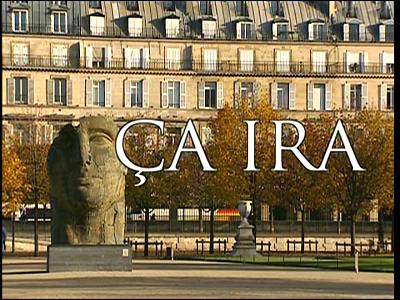 |
| Ca Ira - The DVD |
Written and Directed by Adrian Maben
CLICK HERE to launch an exclusive excerpt from "Ca Ira - The DVD", or download it. It is 6.8MB, and so can even be downloaded by those with a modem internet link. It is in the popular Quicktime format, and is exclusive to the Brain Damage website.
Over fifteen long years in the making, Roger Waters new Classical opera "Ca Ira" will undoubtedly stir up very strong opinions across the Popular and Classical Music worlds. It is actually amazing to realize that we are finally here. The genesis of this project began with Roger's first meetings with Etienne and Nadine Roda-Gil in 1988, a year before the Bicentennial of the French Revolution, for the purpose of providing music for their fifty page libretto.
Roger was so transfixed by Nadine's beautiful illustrations and Etienne's French libretto, essentially lyrics telling the history of the French Revolution, that there was no turning back.
These early meetings came together
through mutual friends; Philippe Constantin (from French Pathe
Marconi/EMI), Etienne and Roger whom together shared similar interests
in music, art and politics. Enthusiastic and inspired, Roger began
constructing early demos at the upstairs studio in his Hampshire home.
These first forays into classical composition became known as "demo 1".
This was long before Sony Classical took a real interest in the
project, later to strongly persuade Roger to translate the French
libretto into English.
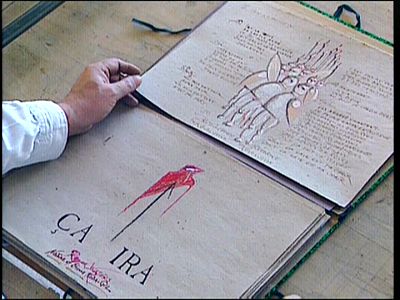 |
| Ca Ira - Nadine's illustrations |
"Ca Ira" is also singularly one of the most ambitious projects in which an established rock musician has ever embarked. This multi-faceted opera became a life-affirming testament to perseverance and commitment.
Over the last ten years film director Adrian Maben, whom we all came to know well through the original and Director's Cut of Live at Pompeii, documented the project through its many incarnations, from conception to completion. This project includes revelatory interviews with Waters and the cast of "Ca Ira" as well as exclusive in-the-studio footage of the recording of the opera. That anyone would follow through with a film documentary for that long a duration is amazing in itself, but then art knows no limits.
The first thing that strikes you
about "CA IRA, The DVD" is how relaxed the overall atmosphere is. The
conversations between the principal characters flow naturally and
intuitively. This is how everyone would imagine the ideal environment
for creativity. You come away with the feeling that you are part of the
conversation rather than just an observer. Roger plays many roles -
creator, collaborator and music coordinator to name just three.
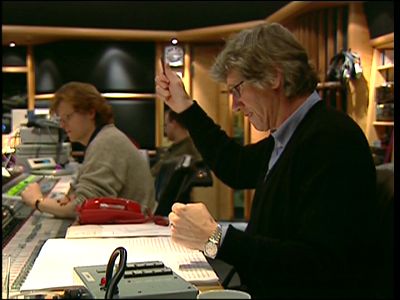 |
| Roger supervising orchestrations |
The first "Ca Ira" tragedy struck in 1990 when Nadine dies of leukemia shattering her husband Etienne. During their first meeting Roger found Nadine to be full of life and unwavering in her resolve; "She struck me as being very intense - a bit spiky, like she was not going to take any crap from anyone, even me!" Roger did not know at the time Nadine was quite sick, which amazed him even more, considering the quality and quantity of work she produced in her last years. Looking back Roger reflected, "She was absolutely focused on this piece of work. Her illness focused her to produce an extraordinary amount of work." Also in this period of time, from 1990 onwards, Roger is consumed in the recording and promotion of Amused To Death, his last Rock studio record released in 1992. The "Ca Ira" project is shelved for almost five years.
In 1995, Roger began work on "Ca
Ira" again, picking up the momentum when he decides to work with
orchestrator Rick Wentworth. Rick was a good choice as collaborator,
also an excellent musician in his own right. In his Hampshire studio,
Roger and Rick began to notate the score on what was at the time an
ancient Atari computer, painstakingly moving the music notes from
computer to paper in order to facilitate a more efficient composing
process. Roger explains that no one in their right mind would use this
kind of computer and software system now. The American company Emagic,
Roger expanded, has since come out with Logic and Logic Pro which has
become the music composing standard now. Fast-forward to the present -
Emagic Logic Pro is now owned and marketed by Apple. For chronology
purposes, recording sessions during this period became known as "demo 2".
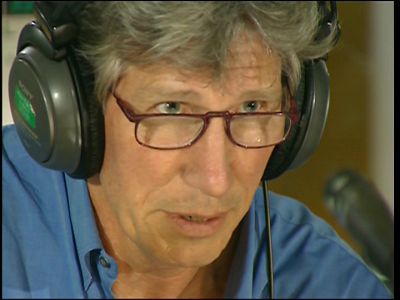 |
| Roger Waters at work |
The opera is undergoing major changes at this point. It is obvious that Sony's decision to become fully involved in "Ca Ira" has geared up the commercial crossover potential for Roger's new operatic work. Over the course of "CA IRA, The DVD" we are introduced to the opera's three main vocalists: Welsh bass-baritone Bryn Terfel, Chinese soprano Ying Huang, and American tenor Paul Groves. It will be these internationally acclaimed singers who will expand the musical accessibility of "Ca Ira" to potentially a worldwide audience.
The choice of language was
perhaps the next significant change of direction for "Ca Ira." In 1997,
Roger began writing an English version of the text. "Originally there
was no intention of making an English version," he said, "I just
assumed we'd record it in French and that would be that, you know. But
after Sony Classical became involved they asked me to make an English
version, and eventually after a lot of resistance I relented, and I am
very glad that I did because it made me think more about the ideas that
were involved in it. It forced me to look at the opera as more of a
theatrical piece as well. After I had done the translations, I started
to write other bits of narrative to help move the plot along, and I
think it has helped the piece. I am very glad I had my arm twisted by
the record company to do that."
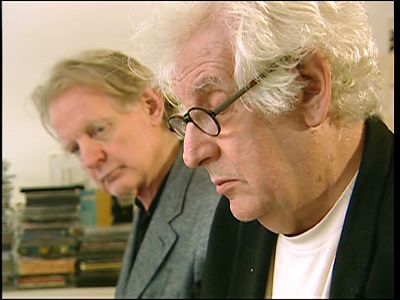 |
| Adrian Maben & Etienne Roda-Gil |
Early on in the "Ca Ira" project, Roger expressed "The fact is that classically trained musicians tend to work from the page. It's hard to get orchestras to play with feel, you know, it's hard to get an orchestra to find the groove!" One of the main instruments is actually the red telephone in the control room (which is a direct link to Rick and the orchestra), played with great skill by Roger!
For me personally, the most rewarding aspect of having the DVD is watching the evolution of a track, specifically "Silver, Sugar and Indigo." Roger wanted to give a more authentic African feel to the piece by doing sessions at Studios de la Seine with a group of Senegalese drummers. While Classical musicians tend to go by the score, rock musicians go by feel, something which you can not put down on paper.
As with most creative endeavors,
trial and error was also the rule with "Ca Ira." As Roger explains -
"This whole section with these guys was me floundering a bit. I could
not work out how to make the "Silver, Sugar and Indigo" section work. I
thought of using Burrundi drummers and all sorts of things. But as time
went on I came to realize more and more, that if this piece was going
to homogenize with the whole opera, it was going to be necessary to
create whatever effect I could using the standard effects of a large
orchestra, chorus and singers like all the other pieces. The one
exception to this general rule is Ismael Lo singing the lead tenor
part. There's something so African about the way he phrases both in
French and English."
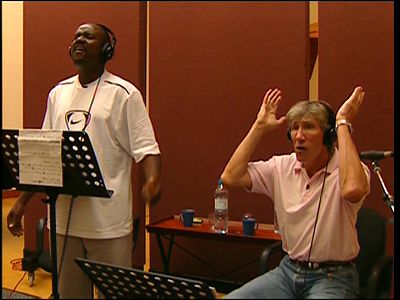 |
| Ismael Lo and Roger Waters |
Watching the two interact in the recording studio is simultaneously amusing and revelatory. During the "Ca Ira" recording sessions, Roger encourages and corrects each of the vocalists, always with great humour and comraderie. If nothing else, you will come away from "CA IRA, The DVD" with a brand new perspective on how Roger works and elicits the best performance out of every musician.
We come to a change of scenery in April 2001 as Roger is interviewed on The Big Wheel in Paris. A number of topics are covered; soprano Ying Huang's unique approach to opera singing, the problems of language and what is wrong with contemporary English opera. The locale of The Big Wheel is significant because it sits on the location where Marie-Antoinette was guillotined. It also offers a unique and changing view of the Louvre, the Tuileries Gardens and the area where the Tuileries Palace used to stand. Adrian Maben has pointed out that this is the same Big Wheel that was first assembled for the Bicentennial celebrations of the French Revolution in July 1989. As the Big Wheel turns Roger comments dryly, "It's just another revolution."
May and June 2001 marks the
beginning of recording sessions at Sony Studios in London. American
tenor Paul Groves and Welsh bass-baritone Bryn Terfel each do very
insightful interviews and discuss their motivations for getting
involved with "Ca Ira." Paul Groves looks to the future of Classical as
a "kind of fusion of worlds: rock, Broadway, classical, reggae - all
these things coming into one, which makes it very exciting, you know,
it's something new." His excitement with "Ca Ira" peaked "when I first
picked up this piece and was reading it at the piano - it was about
emotion and that's why I do this job."
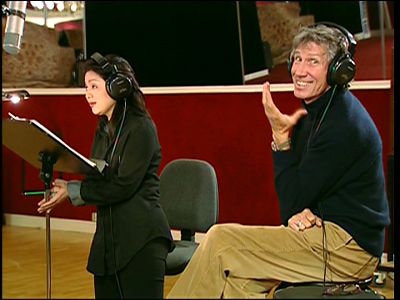 |
| Ying Huang & Roger Waters |
The third "Ca Ira" tragedy struck in 2004, and this time it is a major catastrophe - Etienne Roda-Gil dies of a stroke. Etienne was perhaps the closest friend and collaborator Roger had on the project. Memories of Nadine, Philippe and now Etienne are everywhere in "CA IRA, The DVD" and their images on the video suddenly become very special. After Etienne's death, the nagging question returns one more time, "Will Roger ever finish Ca Ira?"
Finally in the first months of 2005, Roger is driven to finish "Ca Ira." He tweaks the audio tracks and adds simple but effective sound effects. And Simon Rhodes, the sound engineer, also does a remarkable job completing the final mix. There were times when people expressed doubts if "Ca Ira" would be completed, but as Rick Wentworth said "the great thing about Roger is that when he starts something he sticks to it." "Ca Ira" now stands complete - the only real question is, how will the music world react to Roger Waters brave new music?
Watching "CA IRA, The DVD" reminds us all that liberty isn't without some sort of sacrifice, "Not withstanding that it is rooted in the history of the French Revolution," said Roger, "it is about revolution in the broadest sense, it is about change and it is about personal change, and the idea which I'm now getting into my English version is that we each have within us the potential for republic. By that I mean the potential to empathize with others to a point where we choose more humane options. I guess that is why Etienne wrote the libretto in the first place. You know, he had this feeling that this is an important story for everyone."
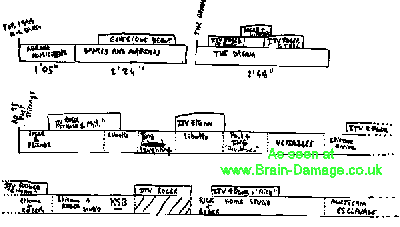 |
| View the editing schema used by Adrian Maben during the creation of the documentary |
Sony BMG Masterworks/Columbia Records releases Roger Waters "Ca Ira" on September 27th. Here's what you need to know: "Ca Ira" is an opera in three acts for full orchestra, soloists and choirs. The "Ca Ira" DVD comes packaged in the lavish first edition of "Ca Ira," the audio CDs are Hybrid SACD, which will play on any CD player, but sound especially dynamic and rich when played on a Super Audio capable CD player.
The lavish double SACD Digipack also contains a 60 page four-color booklet with Roger Waters' lyrics based on Etienne Roda-Gil's original French libretto, the original illustrations created by Nadine Roda-Gil, biographies of Waters and the opera's cast, background and production notes on the opera. A standard two CD edition is also available without the DVD or book.
To maximize the full sensory impact of "Ca Ira," I recommend having both the DVD and CDs as they are complimentary and inseparable. All whom experience "Ca Ira" in any form, will certainly approach it with great curiosity, if not some trepidation. This is a normal reaction to anything brand new - to really enjoy Roger Waters new music requires an open mind, fresh ears and a considerable amount of patience. "Ca Ira" then rewards the listener exponentially with its rich lyrical concept and sweeping sonic beauty. To fully experience "Ca Ira" and its accompanying DVD is to open your heart to a journey of enlightenment.
Written by Brain Damage's Paul Powell Jr., September 2005
sources:
- The Making of "Ca Ira" DVD (for quotes)
- Official Sony/BMG press release for Ca Ira (info)
- Ca Ira: Dates and Notes by Adrian Maben (chronology, info, and quotes)
- www.ca-ira.com (official Sony Classical site) (info)
The digipack version of Ca Ira, which includes the DVD, can be ordered through the following special links: Amazon UK/Elsewhere, US/International, Canada, France, or Germany.